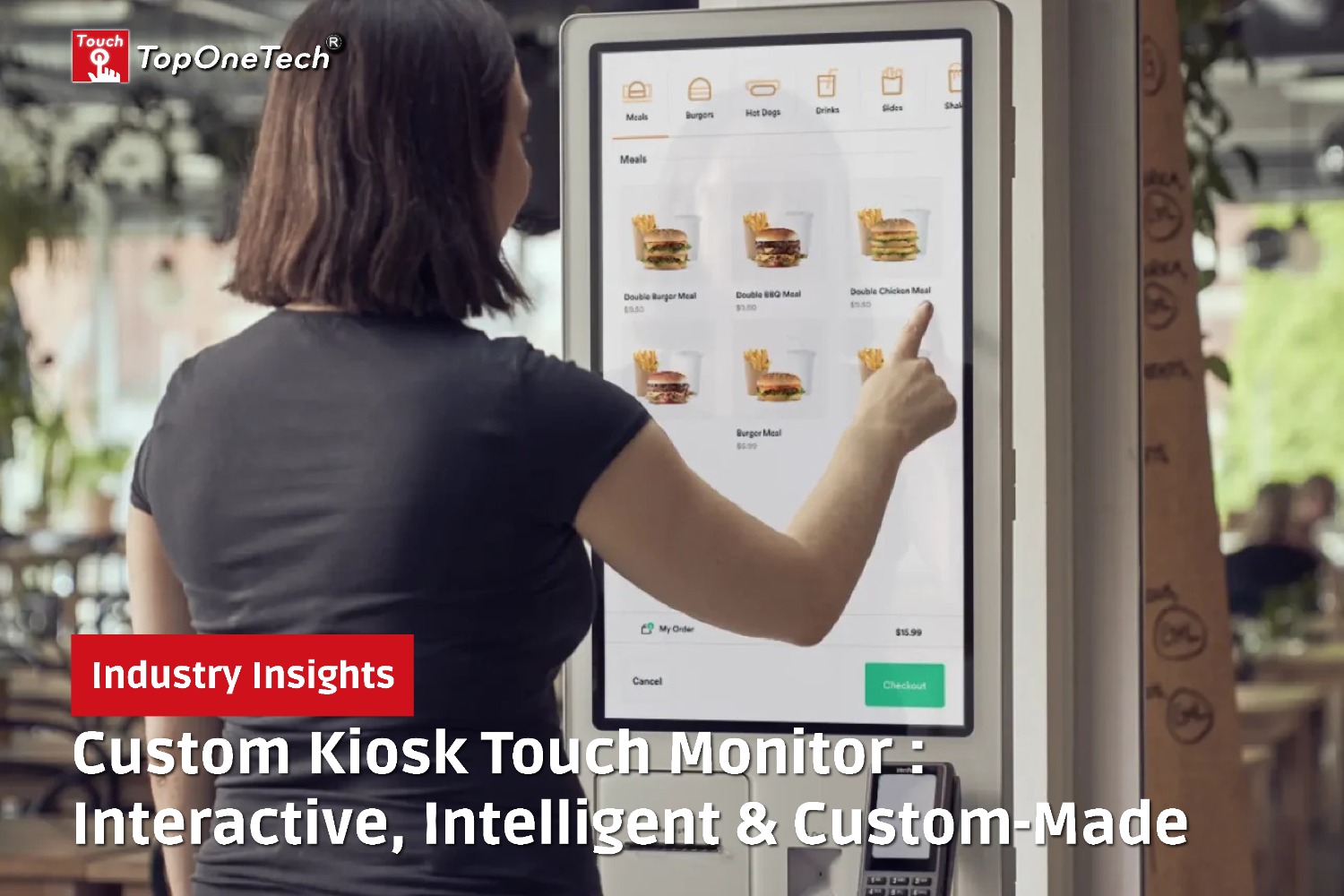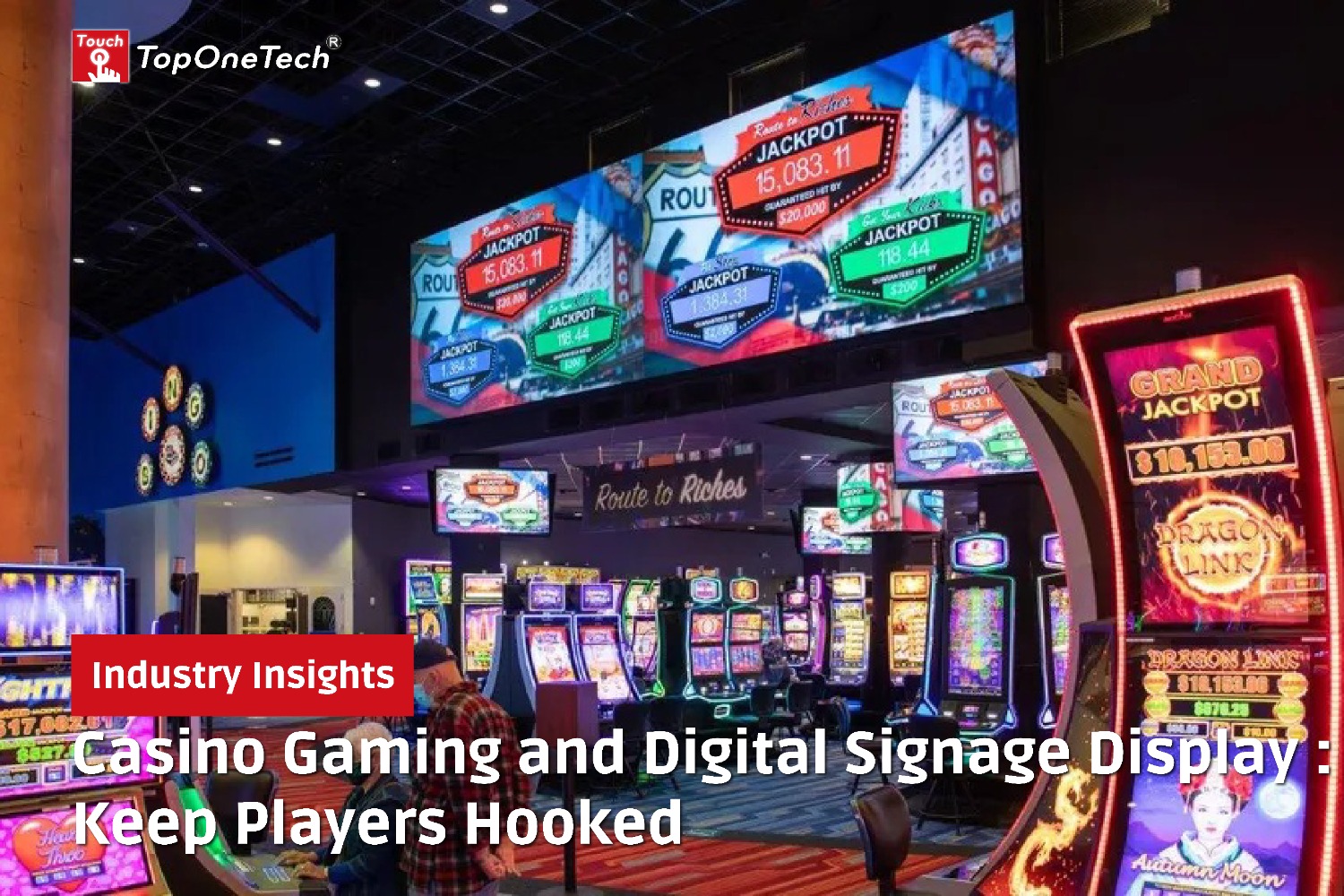
Touchscreen Monitor for Kiosk : Fast&Smarter Customer Interaction – In the digital age, customer expectations are higher than ever before. With increasing reliance on mobile devices and on-demand services, people expect instant results, minimal friction, and a personalized touch. Traditional customer service methods, while still relevant, are often too slow or resource-heavy to meet this demand at scale. Businesses need to find a way to maintain personal service without overwhelming staff or driving up operational costs.
This is where touchscreen monitors for kiosks enter the scene. These interactive displays form the cornerstone of modern self-service solutions, enabling customers to help themselves quickly and intuitively. Whether deployed in retail stores, hospitals, airports, or restaurants, touchscreen kiosks create a smarter and more efficient customer experience—empowering users while optimizing business operations.
What is a Touchscreen Monitor for Kiosks?
A touchscreen monitor for kiosks is a specialized display integrated with touch functionality that allows users to interact with digital content by tapping, swiping, or dragging directly on the screen. Unlike traditional screens that rely on peripheral devices like a mouse or keyboard, touchscreen monitors are designed to offer an immersive, direct interface between the user and the system.
These monitors are usually built with Projected Capacitive (PCAP) or Resistive Touch Technology, providing high responsiveness and durability. Enclosed within rugged, tamper-resistant casings, they are suitable for environments that require frequent public use. The displays are often mounted into self-service kiosks used in public spaces to carry out functions like checking in, browsing services, making payments, or navigating information systems. They combine functionality, durability, and user-friendliness—making them indispensable in modern customer-facing infrastructure.
The Rise of Self-Service Kiosks: Why Touchscreen Monitor for Kiosk Is Essential
Self-service kiosks have become ubiquitous in today’s customer service environments. Whether you’re at a train station, a fast-food outlet, or a government office, there’s a high chance you’ve used one. The success of these kiosks largely depends on their interactive touchscreen monitors, which serve as the primary interface for user interaction.
Key Drivers for Adoption:
-
Speed and Convenience: Customers can complete tasks like checking in, purchasing, or finding information without human intervention. This shortens queues and accelerates service times.
-
24/7 Availability: Unlike staffed service counters, kiosks can operate continuously, making them ideal for locations that require around-the-clock service.
-
Cost Efficiency: Businesses can reallocate human resources or reduce staffing altogether by letting kiosks handle routine or repetitive tasks.
-
Accuracy: Touchscreens reduce the chance of miscommunication or clerical errors, especially when customers input their own information directly.
The adoption of touchscreen kiosks reflects a broader societal shift toward automation and self-reliance, where convenience and autonomy are not just valued but expected.
Benefits of Touchscreen Monitor for Kiosk Applications
1. Enhanced Customer Experience
Customer experience is everything in today’s competitive market. Touchscreen monitors offer an intuitive, straightforward interface that makes the customer journey more enjoyable. Users can interact with the system using gestures they already know from smartphones and tablets, reducing the learning curve and making the process feel natural and empowering.
Whether it’s browsing restaurant menus, registering for an appointment, or navigating maps, the ease of use translates into increased customer satisfaction. People appreciate the control and autonomy these interfaces provide, especially when compared to waiting in line or dealing with complicated procedures.
2. Faster Transactions
Touchscreen kiosks are engineered for speed. Each tap and swipe translates into an immediate response, allowing tasks to be completed in seconds rather than minutes. This reduction in service time benefits both users and businesses: customers appreciate not having to wait, while businesses can serve more customers in the same amount of time.
The speed is especially crucial during peak hours—whether in fast food restaurants, airports, or retail outlets—when fast throughput is key to maintaining order and delivering a positive experience.
3. Accessibility
Modern kiosk touchscreens are built with inclusive design principles in mind. Features such as height adjustability, multi-language support, voice prompts, and visual cues make them accessible to a broad range of users, including those with disabilities.
Anti-glare screens, large icons, and adjustable brightness settings further enhance readability for users with visual impairments. These considerations are not just about compliance with regulations like the ADA (Americans with Disabilities Act)—they’re also essential for creating a welcoming and user-friendly service point for everyone.
4. Real-Time Updates and Integration
Touchscreen kiosks can be connected to back-end systems via the cloud, enabling them to display real-time data and dynamic content. Retailers can update prices, promotions, and stock levels instantly. Healthcare providers can sync patient records across systems. Transit agencies can show up-to-the-minute schedules and alerts.
This interconnectivity enhances operational efficiency while ensuring that customers always have access to the most current information.
5. Durable and Low-Maintenance
Unlike standard consumer displays, kiosk touchscreen monitors are built for 24/7 commercial use. They feature tamper-proof designs, high-impact-resistant glass, and enclosures that can withstand dust, moisture, and temperature fluctuations.
This makes them a low-maintenance investment. Fewer breakdowns and longer lifespans translate to lower total cost of ownership, while ensuring consistent performance in demanding environments.
Top Industries Benefiting from Touchscreen Monitor for Kiosk
Retail
Retailers use touchscreen kiosks for purposes ranging from self-checkout systems to product information stations and gift registry lookups. These interactive stations not only improve customer convenience but also help increase upselling opportunities. When linked to inventory and recommendation engines, touchscreen monitors can show relevant products or deals, boosting sales and engagement.
Hospitality and Food Services
In restaurants, touchscreen kiosks facilitate self-ordering, which improves order accuracy and reduces wait times. Hotels implement check-in kiosks that reduce front desk congestion and let guests personalize their stay preferences. In both cases, the touchscreen interface simplifies interactions while freeing up staff to handle more complex guest needs.
Healthcare
Touchscreen monitors in medical kiosks are revolutionizing patient intake. They manage check-in, insurance processing, symptom reporting, and even virtual triage. These solutions reduce wait times, minimize paperwork, and protect patient privacy, while allowing medical staff to focus more on care than administration.
Transportation
Touchscreen kiosks in airports, bus stations, and metro systems provide travelers with self-check-in options, ticket purchases, wayfinding, and real-time schedule updates. These kiosks improve traveler independence while reducing crowding at service counters.
Government Services
Touchscreen kiosks streamline public service delivery, enabling tasks like renewing licenses, paying fines, and requesting official documents. These digital service points reduce foot traffic in government offices, shorten wait times, and ensure greater transparency and efficiency.
Key Features to Look for in a Touchscreen Monitor for Kiosk
When selecting a touchscreen monitor for kiosk applications, it’s vital to consider a blend of technical specs and usability features:
Multi-Touch Capability
Modern touchscreens support multi-touch gestures such as pinching, zooming, and rotating. This allows users to interact more dynamically with the interface, improving the user experience—particularly for applications like maps, image galleries, or product browsing.
High Brightness and Clarity
Public-facing kiosks need displays that are clearly visible under all lighting conditions. High-brightness monitors with Full HD or 4K resolution ensure sharp visuals, while anti-glare coatings improve legibility even in direct sunlight.
Robust Build Quality
Kiosk touchscreens should be engineered for heavy usage. Industrial-grade components, vandal-proof glass, and IP-rated enclosures protect the display from environmental hazards and tampering.
Versatile Mounting Options
Whether you’re designing a wall-mounted kiosk, countertop solution, or freestanding terminal, the monitor must accommodate different mounting formats such as open-frame, panel-mount, or VESA.
OS Compatibility and Connectivity
Touchscreen monitors should integrate easily with various operating systems like Windows, Android, and Linux. They should offer flexible connectivity options including USB, HDMI, VGA, and RS232, ensuring compatibility with existing kiosk hardware.
Anti-Glare and Anti-Smudge Coatings
These coatings enhance readability and maintain screen clarity, even after multiple uses. They also reduce the need for frequent cleaning and upkeep, which is crucial for high-traffic environments.
Touchscreen Monitor for Kiosk Long-Term ROI: Why It’s a Smart Investment
While initial investment in touchscreen kiosk technology can be significant, the return on investment is quickly realized through improved operational efficiency and customer satisfaction. Businesses reduce staffing needs and administrative burdens while delivering consistent service quality.
Touchscreen kiosks also collect valuable data on user behavior, transaction trends, and service bottlenecks. This allows companies to make data-driven decisions, personalize services, and refine operational strategies for even greater ROI over time.
Moreover, kiosks are modular and scalable. As your business grows, more kiosks can be added or upgraded with new software functionalities, ensuring long-term value.
Future Trends in Touchscreen Monitor for Kiosk Technology
AI-Powered Interactions
AI is enhancing kiosk intelligence with machine learning algorithms that analyze behavior and offer personalized services. AI-powered kiosks can adjust recommendations based on previous interactions or usage patterns.
Contactless and Gesture Control
Amid health-conscious practices post-pandemic, contactless interfaces using gestures or mobile device synchronization are gaining popularity. These eliminate physical touchpoints while maintaining interactivity.
Biometric Authentication
Biometric integrations like facial recognition, fingerprint scanning, or iris detection offer higher security, especially for banking, healthcare, or ID verification applications.
Cloud-Based Management
Centralized management systems allow businesses to remotely control content, collect analytics, and deploy updates across all kiosks. This ensures consistency and operational control across multiple locations.
Choose Top One Tech as Your Trusted Supplier for Touchscreen Monitor for Kiosk
When it comes to implementing high-performance touchscreen monitors in kiosk applications, Top One Tech stands out as an industry leader. With years of experience in producing robust, reliable, and customizable touch display solutions, Top One Tech offers everything businesses need to power their self-service technologies.
Top One Tech engineers our monitors to deliver durability, responsiveness, and clarity, even in demanding environments like casinos, vending terminals, transportation hubs, and medical facilities. Our company provides a wide range of customization options—including screen size, touch technology, mounting styles, and enclosure design—tailored to meet your unique project requirements.
As a partner, Top One Tech goes beyond just supplying hardware. We provide:
-
Full technical support
-
Professional consultation
-
Global shipping and service
-
Competitive pricing for bulk orders
-
Reliable lead times and after-sales care
By choosing Top One Tech, you’re investing in quality, expertise, and long-term performance—ensuring that your kiosk solutions consistently exceed user expectations and deliver maximum ROI.
Conclusion: Redefining Customer Engagement with Touchscreen Monitor for Kiosk
In conclusion, touchscreen monitors for kiosks are redefining how businesses interact with their customers. Furthermore, they provide a seamless, efficient, and personalized experience that resonates with modern consumer preferences. From reducing lines and improving accessibility to increasing customer engagement and delivering real-time updates, touchscreen monitors have become the gold standard in digital self-service.
As industries continue to digitize and automate, touchscreen kiosks will play an even more critical role in customer service strategies. Choosing the right solution—and the right supplier—can determine the success of your self-service initiative. Top One Tech equips you to meet today’s demands and tomorrow’s challenges with confidence and precision.
Top One Tech can customize Touchscreen Monitor for Self Service Kiosk and we can also customize The Self Service Kiosk, crafted by our subsidiary company, Top One Tech Metal, specially made for your application scenarios.
Don’t hesitate to contact us for further assistance :
Whatsapp/Call us at : +86 13631610695
Email : sales@toponetech.cn



